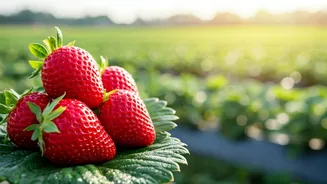Embracing Strawberry Cultivation
Strawberry farming is rapidly gaining traction across India, particularly within the Vindhya region of Madhya Pradesh, where enthusiasm amongst farmers
is clearly visible. This trend signifies more than just a profitable crop; it also opens avenues for new market opportunities, transforming seasonal fields into sources of consistent income. To achieve success, farmers must combine the right knowledge with precise timing and technology. According to Dr. R.P. Joshi, Principal of Rewa Agricultural College, MP, the cool season presents the ideal conditions for strawberry cultivation. The hilly and plain regions around Rewa are suitable, while the forested areas present further chances for large-scale production and impressive yields. For those looking to capitalize on this opportunity, procuring strawberry plants by October allows for cultivation between November and March. This timing often yields excellent returns, making it a lucrative venture for many.
Choosing the Right Varieties
Selecting the right strawberry varieties is pivotal for achieving maximum yield and profitability. Several varieties are particularly well-suited to the climate of Madhya Pradesh. These include Winter Dawn, Camarosa, Sweet Charlie, and Nabila. Each of these options thrives under local conditions, making them ideal choices for farmers aiming to get a head start. The characteristics of these specific strawberry cultivars play a significant role in their success. Proper selection ensures better fruit quality, resistance to local diseases, and higher yields. Farmers should always choose varieties that best match the local environmental conditions to maximize their chances of a profitable harvest. Careful consideration of these elements is a key step towards a thriving strawberry farm, ensuring both quantity and quality in the produce.
Essential Planting Techniques
Successful strawberry cultivation relies heavily on adopting the right techniques from the very beginning. Preparing raised beds is crucial, and employing plastic mulch or drip irrigation systems can enhance the growth environment. Strawberry plants can also be propagated using runners, which is another useful method. Moreover, adequate spacing is essential for plant health and ease of management. Maintaining a distance of 40 cm between plants and 40 cm between rows allows for sufficient sunlight, air circulation, and ease of access during maintenance and harvesting. These methods provide optimum conditions for healthy strawberry growth, reduce the chances of disease, and streamline management activities. Implementing these strategies is a direct step towards enhancing the yields and quality of the crop, and they are critical for any aspiring strawberry farmer.
The Power of Mulching
As temperatures drop, maintaining soil moisture and protecting strawberry plants from cold stress becomes a significant challenge. This is where mulching becomes highly effective. Mulching aids in conserving moisture, managing weeds, and regulating soil temperature, keeping the fruit clean and disease-free by preventing direct contact with the soil. Farmers can easily create mulch using rice husk, dried leaves, wood chips, compost, or even straw. Among these, straw or dry grass, especially from wheat residue, is considered the best indigenous mulch. It not only protects the plants from frost and pests but also enriches soil fertility, further benefiting the crop. Studies and field experiences show that mulching can increase strawberry yields by 20% to 30%, which is a significant boost for any farmer. Straw mulch, in particular, is an affordable and environmentally friendly method that helps farmers protect their crops and boost their profits.
Nurturing Healthy Growth
Maintaining a healthy strawberry crop is essential for achieving a high yield and top-quality fruit. Balanced soluble fertilizer and adequate watering are key components of proper care. Under good management, strawberries begin flowering within 45–50 days, and the first harvest is typically expected within 80–90 days. Each plantation can yield six to seven harvests, with the first fruits usually being the largest in size. Furthermore, farmers must be vigilant regarding fungal diseases, which can affect the leaves and reduce productivity. Regular application of fungicides helps prevent such infections, safeguarding the plants. Applying fertiliser immediately after the first harvest assists in sustaining fruit quality, ensuring continued productivity and profitability. These combined practices ensure a vigorous strawberry crop.
















